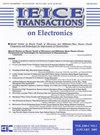基于0.18 μm CMOS技术的全差分分布式电感耦合放大器
IF 0.6
4区 工程技术
Q4 ENGINEERING, ELECTRICAL & ELECTRONIC
引用次数: 0
摘要
本文提出了一种采用耦合电感的紧凑全差分分布式放大器。差分分布式放大器在光通信系统中有着广泛的应用。过去报道的大多数分布式放大器都是单端或伪差分放大器。此外,差分分布式放大器需要许多电感,这增加了硅的成本。在这项研究中,我们使用差分耦合电感将芯片面积缩小到一半以下,并消除了布局设计的困难。使用耦合电感的挑战在于电容寄生耦合会降低频率响应的平坦度。为了解决这一问题,采用简单的无损模型推导了差分人工传输线的奇模图像参数。在分析结果的基础上,采用梯度下降算法对电感的尺寸进行优化,以实现精确的阻抗匹配和相位匹配。该放大器采用0.18 μm CMOS工艺制作。放大器的核心面积为0.27 mm2,比以前的工作缩小了57%。此外,由于优化,我们证明了±2.7 ps的小群体延迟变化。放大器成功地进行了30 gbps的NRZ和PAM4传输,具有优越的抖动性能。该技术将促进差动行波器件的高密度集成。本文章由计算机程序翻译,如有差异,请以英文原文为准。
A Compact Fully-Differential Distributed Amplifier With Coupled Inductors in 0.18-μm CMOS Technology
SUMMARY This paper presents a compact fully-differential distributed amplifier using a coupled inductor. Differential distributed amplifiers are widely required in optical communication systems. Most of the distributed amplifiers reported in the past are single-ended or pseudo-differential to-pologies. In addition, the differential distributed amplifiers require many inductors, which increases the silicon cost. In this study, we use differentially coupled inductors to reduce the chip area to less than half and eliminate the difficulties in layout design. The challenge in using coupled inductors is the capacitive parasitic coupling that degrades the flatness of frequency response. To address this challenge, the odd-mode image parameters of a differential artificial transmission line are derived using a simple loss-less model. Based on the analytical results, we optimize the dimensions of the inductor with the gradient descent algorithm to achieve accurate impedance matching and phase matching. The amplifier was fabricated in 0.18-μm CMOS technology. The core area of the amplifier is 0.27 mm 2 , which is 57% smaller than the previous work. Besides, we demonstrated a small group delay variation of ±2.7 ps thanks to the optimization. the amplifier successfully performed 30-Gbps NRZ and PAM4 transmissions with superior jitter performance. The proposed technique will promote the high-density integration of differential traveling wave devices.
求助全文
通过发布文献求助,成功后即可免费获取论文全文。
去求助
来源期刊

IEICE Transactions on Electronics
工程技术-工程:电子与电气
CiteScore
1.00
自引率
20.00%
发文量
79
审稿时长
3-6 weeks
期刊介绍:
Currently, the IEICE has ten sections nationwide. Each section operates under the leadership of a section chief, four section secretaries and about 20 section councilors. Sections host lecture meetings, seminars and industrial tours, and carry out other activities.
Topics:
Integrated Circuits, Semiconductor Materials and Devices, Quantum Electronics, Opto-Electronics, Superconductive Electronics, Electronic Displays, Microwave and Millimeter Wave Technologies, Vacuum and Beam Technologies, Recording and Memory Technologies, Electromagnetic Theory.
 求助内容:
求助内容: 应助结果提醒方式:
应助结果提醒方式:


